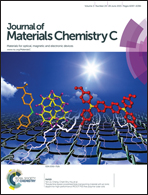Moisture-responsive films consisting of luminescent polyoxometalates and agarose†
Abstract
Novel switchable and tunable luminescent composite films consisting of Na9[EuW10O36]·32H2O (EuW10) and agarose have been prepared. EuW10 can be converted into a non-luminescent species by photoreduction and the recovery is facilitated by oxidation under moisture air. The luminescence recovery of the UV-reduced films showed dependence on the relative humidity (RH) ranging from 43 to 78% after a certain exposure time. X-ray photoelectron energy spectroscopy (XPS) measurements confirm the generation of the reduced W5+ species in EuW10 polyoxoanions. Further analysis of EuW10 indicates that the photo-generated d1 electron hopping is prohibited in the hybrid films. The absence of recombination of the photogenerated d1 electrons and holes, and the consumption of holes to form ˙OH radicals are responsible for the luminescence quenching rather than luminescence resonance energy transfer (LRET). The moisture-responsive behavior of the EuW10–agarose films is attributed to the kinetically controlled back reaction of W5+O6 with O2. The present study provides new insights into lanthanide-containing POMs as tunable luminescent components in UV and moisture dual-responsive materials.


 Please wait while we load your content...
Please wait while we load your content...